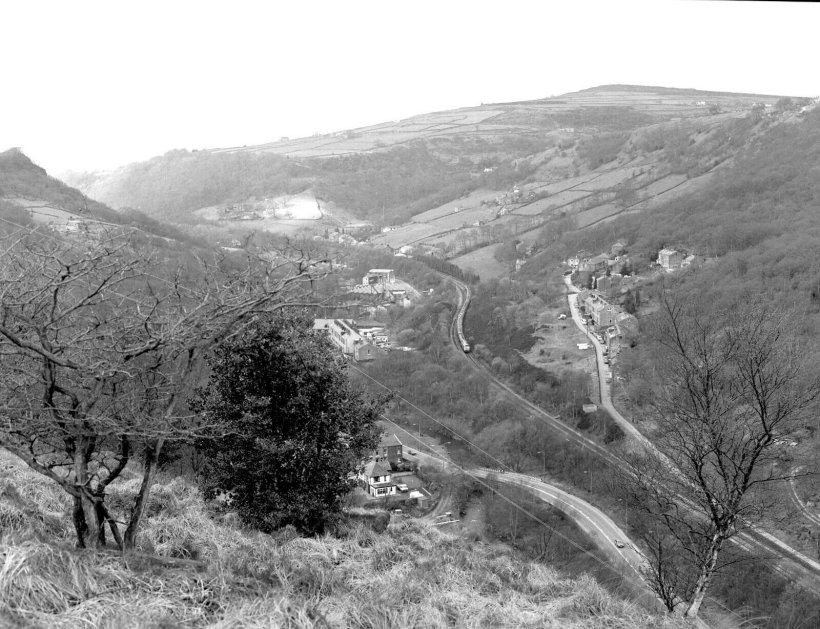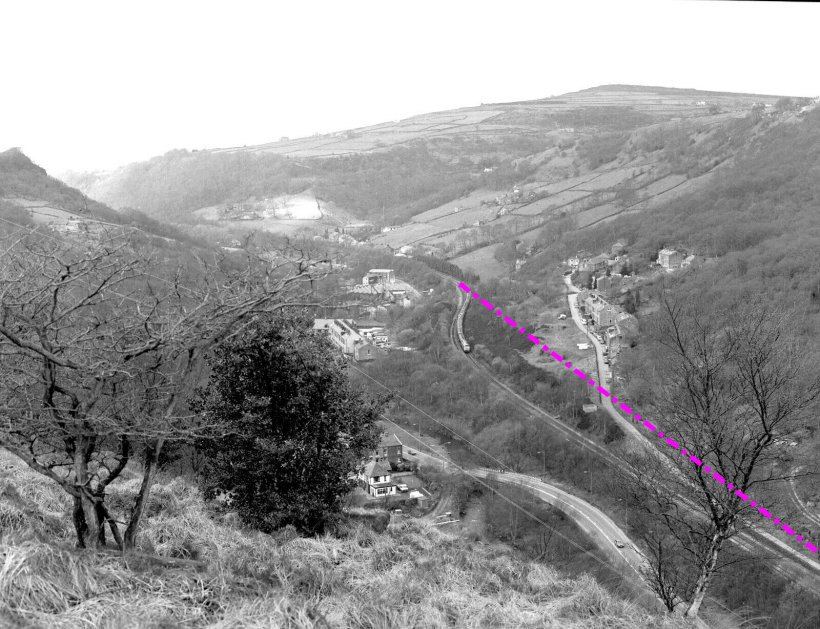
The Charlestown curves
The Charlestown curve lies between Eastwood and Hebden Bridge, and was not part of the original plan, and the line was intended to pass in a 250 yard tunnel under the flanks of Knott Wood on the eastern side of the Calder Valley.However, the hillside was composed of sand-like material that flowed into the tunnel excavations, such that it proved impossible to actually dig the tunnel. Consequently the tunnel was abandoned in favour of a diversion via a 30ch-radius curve (imposing a speed restriction on the line). This deviation was to the west, and run along the hillside line until it rejoined the original alignment at Charlestown Viaduct, otherwise known as Berry Lane Viaduct, built 1848-50.
The structure consisted of three stone spans over the roadway and a cast-iron span over the Rochdale Canal. According to John Marshall, this was replaced by the LMS during the 1940s. The original girders were similar to Guxholme viaduct, but in the case of Gauxholme, the original structure was retained but significant reinforced.
Eric Mason in his 'The Lancashire & Yorkshire Railway in the 20th Century' talks about the Charlestown curve "which, as driver's know only too well, is a curb on speed.... The curve is one of the difficult spots on the Yorkshire section of the railway and is treated with great respect by drivers."
Malcolm Bull's Calderdale Companion records four incidents at the Charlestown curves, namely:
> Friday, 21st June 1912 4 dead, 5 seriously injured, and over 20 slightly injured when an engine of the Lancashire & Yorkshire Railway, pulling 7 carriages, took the Charlestown Curve – between Hebden Bridge and Todmorden – bend too quickly and left the rails, crashing into the embankment.
> Saturday, 15th April 1916 About 10:00 pm, a goods train with 85 wagons broke in half as it approached Hebden Bridge on the Charlestown Curve. The front portion pulled up at Luddendenfoot, and the rear portion at Mytholmroyd.
> Saturday, 9th February 1924 Rail smash at Charlestown Curve
> Wednesday, 2nd January 1929 A heavily-laden goods train en route between Liverpool and Bradford broke in two on the Charlestown Curve. The drivers were unaware and the front section travelled more than 2 miles towards Mytholroyd before it was discovered and the train stopped. The second part then crashed into the stationary section. Thomas Poole, the guard, was slightly injured.
The 1912 accident is the one which saw the start of the demotion of Aspinall's famous 2-4-2 Radial tanks from Express work. The Liverpool to Leeds express hauled by loco number 276 left Rochdale at 2:45 pm and was due to arrive in Halifax at 3:04 pm. The driver was G. H. Medley, and the stoker was A. Broadhurst; both men came from Newton Heath and escaped with slight injuries. Three wooden carriages were completely wrecked. A coffin with the body of a 55-year old Mr Horsefield, which was being carried on the train, was shattered and the corpse kept in a signal box until a new coffin was available.
Crucially a report by Colonel Druitt, recommended that the speed of trains on curves should be recorded so that drivers could be informed when the exceeded the authorised speed. There was a speed restriction of 45 mph on the curve, but there was evidence that this was continually exceeded. Mason notes that the whole of the train left the track. No defect was found on the engine but Druitt noted the great strain thrown on the permanent way when this heavy tank engine was run at a high speed of 60 mph or more over a properly transitioned curve of 30 chains radius and a super elevation of 5 inches.The road was forced bodily out of alignment over a length of 175 yards in the rear of the derailment, a displacement of from 3 to 5.5 inches beginning near the start of the curve and recurring at four other points. Steps were taken to find other work for these powerful and efficient series of engines and so it was that the whole 20 were concentrated at Newton Heath, replacing the Hoy 2-6-2Ts on the Oldham, Rochdale and other branch services. The other major accident involving a Radial on Express work was on 1 July 1903 when loco number 670 derailed at Waterloo station in the Northern suburbs of Liverpool due to a breakage of a trailing coupled wheel spring.
Stephen Chapman's photograph below shows a Class 47 that has entered the curves from the north with a Weaste - Port Clarence empty fuel tankers on 3 April 1991.

Photograph Stephen Chapman. Copyright J K Wallace, all rights reserved.
The second image shows the tunnel alignment marked with the bright pink line and this very clearly shows the severity of the curves introduced with the deviation, and the vastly superior original alignment. I is obvious from the photograph that the sharpest curvature occurs at the point the deviation deviates, and it is a shame that the engineers didn't feel that could reduce its severity by starting the curve further north.

Photograph Stephen Chapman. Copyright J K Wallace, all rights reserved.
